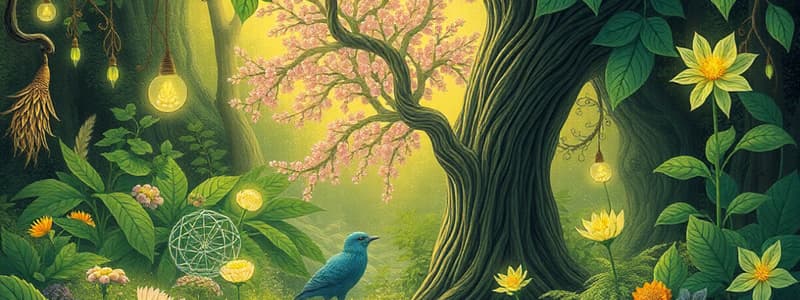Podcast
Questions and Answers
What does sustainability primarily aim to achieve in human interactions with the natural world?
What does sustainability primarily aim to achieve in human interactions with the natural world?
- Minimizing resource consumption at all costs
- Maximizing economic growth regardless of environmental impact
- Reducing human population to decrease resource demand
- Ensuring interactions can continue indefinitely (correct)
Which factor is critical for a population to maintain sustainable yields?
Which factor is critical for a population to maintain sustainable yields?
- Population sizes that can fluctuate significantly
- High reproduction rates exceeding natural disasters
- Eliminating natural predators to enhance growth
- Harvesting at a rate lower than the population's growth capacity (correct)
What characterizes a sustainable ecosystem?
What characterizes a sustainable ecosystem?
- Constant introduction of new species to maintain balance
- Absence of species diversity
- Continuous recycling of nutrients and energy from the sun (correct)
- Dependence on non-renewable energy sources
How can human systems achieve sustainability?
How can human systems achieve sustainability?
What defines unsustainable practices in resource management?
What defines unsustainable practices in resource management?
What is a potential outcome of achieving sustainability in society?
What is a potential outcome of achieving sustainability in society?
Which statement about primitive societies and sustainability is true?
Which statement about primitive societies and sustainability is true?
Which of the following best describes the concept of sustainable yields?
Which of the following best describes the concept of sustainable yields?
What percentage of energy is typically transferred from one trophic level to the next in an ecosystem?
What percentage of energy is typically transferred from one trophic level to the next in an ecosystem?
Which of the following statements about food chains and food webs is true?
Which of the following statements about food chains and food webs is true?
Which of the following elements is NOT a key element in living organisms?
Which of the following elements is NOT a key element in living organisms?
What is the primary role of producers in an ecosystem?
What is the primary role of producers in an ecosystem?
In the photosynthesis equation, what is produced alongside glucose?
In the photosynthesis equation, what is produced alongside glucose?
Which of the following spheres is NOT part of the biosphere?
Which of the following spheres is NOT part of the biosphere?
What commonly characterizes a food web compared to a food chain?
What commonly characterizes a food web compared to a food chain?
Which macromolecule is primarily synthesized during photosynthesis?
Which macromolecule is primarily synthesized during photosynthesis?
What is the primary consequence of cultural eutrophication?
What is the primary consequence of cultural eutrophication?
Which of the following has NOT traditionally been used by farmers to combat pests and soil erosion?
Which of the following has NOT traditionally been used by farmers to combat pests and soil erosion?
What was a significant change in agriculture brought about by the Industrial Revolution?
What was a significant change in agriculture brought about by the Industrial Revolution?
How much of the global land is occupied by agriculture?
How much of the global land is occupied by agriculture?
What impact does excessive fertilizer use have on water sources?
What impact does excessive fertilizer use have on water sources?
What is one of the primary purposes of glucose produced by photosynthesis in plants?
What is one of the primary purposes of glucose produced by photosynthesis in plants?
What has happened to the percentage of crops lost to pests despite the tripling of pesticide use since 1970?
What has happened to the percentage of crops lost to pests despite the tripling of pesticide use since 1970?
What occurs to the majority of glucose consumed by animals?
What occurs to the majority of glucose consumed by animals?
Which process is responsible for breaking down organic matter and returning nutrients to the ecosystem?
Which process is responsible for breaking down organic matter and returning nutrients to the ecosystem?
What is a major concern related to current irrigation practices?
What is a major concern related to current irrigation practices?
Which of the following statements about organic farming is true?
Which of the following statements about organic farming is true?
What is the result of energy flow through an ecosystem?
What is the result of energy flow through an ecosystem?
What percentage of food consumed by consumers is generally converted to body tissue?
What percentage of food consumed by consumers is generally converted to body tissue?
Which of these factors does NOT affect the biotic potential of a population?
Which of these factors does NOT affect the biotic potential of a population?
Why is only a small fraction of energy passed on from one trophic level to the next?
Why is only a small fraction of energy passed on from one trophic level to the next?
Which of the following statements about cellulose in detritus feeders is true?
Which of the following statements about cellulose in detritus feeders is true?
What is one main consequence of water logging on irrigated land?
What is one main consequence of water logging on irrigated land?
What is meant by the term 'Green Revolution'?
What is meant by the term 'Green Revolution'?
Which statement about factory-style farming is accurate?
Which statement about factory-style farming is accurate?
What percentage of the USA's grain crop is used for animal feeding?
What percentage of the USA's grain crop is used for animal feeding?
How does the accumulation of animal manure in developed countries typically impact the environment?
How does the accumulation of animal manure in developed countries typically impact the environment?
What is a significant environmental effect of converting tropical rain forests to pasture in Latin America?
What is a significant environmental effect of converting tropical rain forests to pasture in Latin America?
What impact do ruminant animals have on climate change?
What impact do ruminant animals have on climate change?
What proportion of the world's croplands is used to feed animals?
What proportion of the world's croplands is used to feed animals?
Study Notes
Sustainability
- A system or process is sustainable if it can be continued indefinitely without depleting energy or materials
- Sustainable yields are a key component of forestry and fishery practices
- Harvesting trees or fish at a rate exceeding their natural growth rate is unsustainable
- Sustainable ecosystems recycle nutrients, maintain species diversity, and use solar energy sustainably
Producers and Photosynthesis
- Plants are producers and convert sunlight to chemical energy through photosynthesis
- Photosynthesis: 6CO2 + 6H2O → C6H12O6 + 6O2
- Chlorophyll absorbs light energy to split water molecules, releasing oxygen and creating glucose
- Glucose is used for plant growth, storage (starch, oils), and to form other organic molecules
Consumers
- Consumers obtain energy by consuming other organisms
- Cellular respiration breaks down glucose for energy: 6O2 + C6H12O6 → 6CO2 + 6H2O
- Only a small fraction of consumed food is converted to body tissue, the rest is used for energy or waste
Detritus Feeders and Decomposers
- Detritus is mostly cellulose, a major source of food for decomposers and detritus feeders
- Decomposers (e.g., bacteria, fungi) use oxygen to break down organic matter, releasing nutrients, water, carbon dioxide, and heat
- Termites have symbiotic relationships with microbes in their gut to digest cellulose
Food Chain and Food Web
- Food Chains represent linear flow of energy from producers to consumers
- Food Webs reflect more complex feeding relationships, where organisms can occupy multiple trophic levels
Biotic Potential vs Environmental Resistance
- Biotic Potential: the ability of populations to increase under ideal conditions
- Factors Affecting Biotic Potential:
- Reproduction rate
- Generation time
- Length of reproductive period
- Survival rates of offspring
- Environmental Resistance: factors limiting population growth
- Predation
- Competition
- Parasitism and Disease
- Lack of resources (food, water, shelter)
Carrying Capacity
- Carrying Capacity: the maximum population size a particular environment can support over a long period
- Factors Affecting Carrying Capacity:
- Food availability
- Water supply
- Shelter
- Climate
- Predator and prey relationships
Modern Industrialized Agriculture
- Modern Agriculture relies heavily on machinery, fertilizers, pesticides, and high-yielding crop varieties
- Increased efficiency has led to increased food production but also environmental consequences
- Consequences of Modern Agriculture:
- Reliance on fossil fuels for machinery
- Land use change (loss of forests and wetlands)
- Water depletion and pollution from irrigation and fertilizer runoff
- Pest resistance to pesticides
- Genetic erosion (loss of biodiversity)
Animal Farming and its Environmental Consequences
- Animal farming has a significant impact on land use, resource consumption, and environmental pollution
- Factory-style farming:
- High grain consumption for livestock feed
- Manure management issues
- Pollution from animal waste
- Greenhouse gas emissions (methane)
Effects of Animal Farming
- Rangeland degradation
- Loss of biodiversity
- Climate change from methane emissions
- Nutrient pollution from animal waste
Subsistence Farming
- Small-scale farming practiced for local food production and consumption
- Often relies on traditional techniques such as crop rotation and animal manure
- Can have a minimal environmental impact if practiced sustainably
Cultural Eutrophication
- Accelerated eutrophication caused by human activities
- Nutrient enrichment of water bodies due to agricultural runoff, sewage disposal, industrial waste
- Leads to algal blooms, oxygen depletion, and ecosystem degradation
Studying That Suits You
Use AI to generate personalized quizzes and flashcards to suit your learning preferences.
Related Documents
Description
This quiz covers key concepts of sustainability, the role of producers in photosynthesis, and the function of consumers in energy transfer within ecosystems. Understand how sustainable practices benefit our environment, how plants convert sunlight into energy, and how consumers derive energy from other organisms. Test your knowledge of these fundamental ecological principles.




